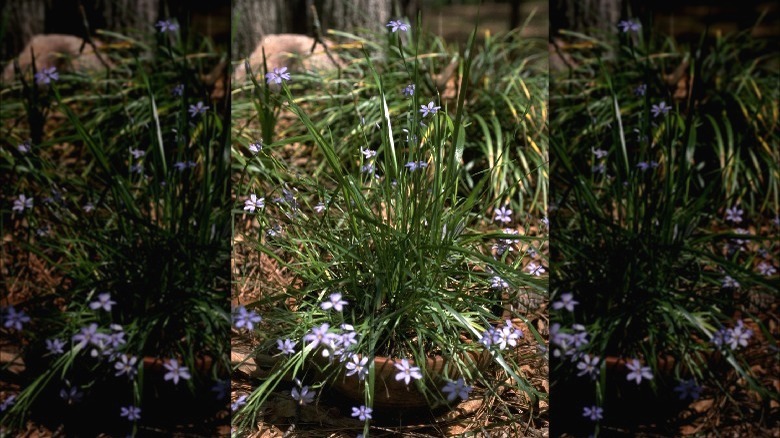Although its taut, lance-shaped, green fronds have fooled many, earning blue-eyed grass (Sisyrinchium) its “grass” moniker, it’s anything but. Its leaves fan out, giving way to flat stalks (spathes) that grow star-shaped, six-petaled blooms, justifying the plant’s place in the iris family. While mostly hued blue, these yellow-centered beauties can be white or lavender too, attracting butterflies and bees to your yard and closing at night to keep the nectar safe. Even songbirds flock to these showy beauties to gorge on their seeds. But keeping the pollinators (and yourself) happy necessitates prolonging the blooming season, making it necessary to deadhead and divide the blue-eyed grass.
Many gardeners say that deadheading — removing bloomed out flowers — can spur this wildflower to develop new buds and rebloom. However, this part isn’t always essential if your variety is naturally predisposed to producing a second bloom around summer’s end. That being said, dividing the slender-leaved perennial every few years after the flowering season ends is a good practice if you want it to flourish.
Deadheading and dividing blue-eyed grass

Cheryl Ann Meola/Shutterstock
Despite their small flowers, blue-eyed grass plants pack an ornamental punch since they bloom profusely. But to keep their look unblemished and tidy, removing the dead flowers after the blooming season ends (depending on the variety) is necessary. This also helps redirect the plant’s resources to setting more buds. Moreover, because the perennial is given to self-seeding, removing the spent blooms can prevent it from becoming invasive.
As blue-eyed grass is short-lived and loses its vitality and vivacity over time, hurting its blooms, you must divide it every 2 to 3 years. To do so, dig out the native plant using a shovel or a garden fork in early spring when it’s about to experience a growth spurt (although fall works, too). Either shake the plant or spray it with water to remove the soil from its root ball. With a sharp shear, carefully partition the plant into smaller clumps, ensuring each specimen retains around 3 to 4 shoots and the roots. Finally, plant the divided blue-eyed grasses in containers to boost root development. If transplanting directly to moist soils, ensure each clump is 6 to 8 inches apart.
Other care tips
As partial shading can adversely impact their flowering, always give your blue-eyed grass plants six hours of direct sunlight to get the best blooms. Counterintuitively, these herbaceous perennials don’t perform well in rich soils, growing leggy and weepy over time. So, plant them in slightly acidic to neutral, sandy, or loamy soils with a low salt content. If you’re worried about the soil’s quality, spread a 3-inch-thick mulch layer around the plant’s base while minimizing stem contact.
Being native to swampy areas, marshes, damp fields, and meadows, these grasses are fond of moist soils, provided they have good drainage. So, plan your watering accordingly to keep the soil from drying out between soakings, particularly during droughts. Although 1 inch of water total per week is usually optimum, you might have to switch things up depending on the variety, rainfall, drainage, and soil composition. Finally, if you’re growing the plant as turfgrass, be wary of it becoming weedy. In such cases, mow down under one third of the blade length and aerate the lawn regularly to raise the plant’s drought tolerance.